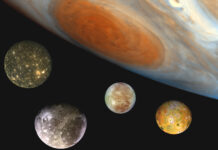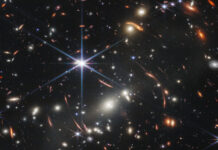The “Harmony of the Spheres,” or musica universalis in Latin, is the ancient philosophical concept that the planets orbit the Sun at set distances and velocities that are harmonious with universal mathematical and physical laws.
While this concept has been around, in one form or another, since even the time of Pythagoras, it is the findings of Johannes Kepler that really begins to put some scientific truth to this concept (as exemplified in his work, Harmony of the World).
Kepler’s Three Laws of Planetary Motion
Kepler’s Three Laws of Planetary Motion are the foundation of our present knowledge on how planets orbit their host stars, as well as how satellites, both natural (“moons”) and man-made, orbit their host planets and how stars in multiple-star systems orbit one another. Ultimately, it is about the galaxy that they are a part of (although, at this scale, things start getting even more interesting).
Kepler’s First Law simply states all orbits are not circular but are in fact elliptical – shaped like flattened circles, to some degree. Their host star or planet occupies one of the “foci” (plural of “focus”) of said ellipse.

Kepler’s Second Law is the so-called “equal areas in equal times” law. To put this as an easy example, each of the Earth’s twelve months can be visualized as twelve wedges that, while each will be wider or thinner in size than others, will always have the same area. This means that Earth will orbit the Sun at a slower speed at its farthest distance from the Sun, and it will orbit at its fastest speed when closest to the Sun.
Kepler’s Third Law is a mathematical equation, P2 = d3, where P is the object’s “true year” (the year-value calculated from the perspective of very distant stars, and not the “observed year” calculated from the perspective of the Sun) and d is the average distance from its host. For example, Earth’s “true year,” which equals its “observed year” is ~365 Earth-days while its observed year is slightly longer; Earth’s average distance is 149.6 million km = 1 AU or “Astronomical Unit.”
Orbital Resonance
Kepler’s Three Laws comprise one layer to the realization of the true nature of the “Harmony of the Spheres.” The next level adds upon Kepler’s seminal findings, showing that planets orbit their host stars, and even for natural satellites orbiting their host planets, at very set distances according to gravitationally-imposed resonances. Called simply “Orbital Resonance,” this aspect was first concretely laid-down by Laplace from his studies of the Galilean Moons of Jupiter. He found that Io, Europa, and Ganymede, in particular, orbit Jupiter according to the ratio 1:2:4. This ratio says that, while Ganymede orbits Jupiter once, Europa orbits Jupiter twice and Io four times.

Another Orbital Resonance that exists here is the 1:4 ratio that exists between Mercury and the Earth, where Mercury’s 88-(Earth) day “year” is roughly ¼ as long as Earth’s own 365-day year. So, “reading” these kinds of ratios means “reversing” the numbers to understand what the ratio actually encodes.
For the Mercury-Earth example above, “1:4” means Mercury completes 4 orbits in the time it takes Earth to complete one.
Excitingly, Orbital Resonance has recently been shown to exist in the TRAPPIST-1 system too. The detailed, physics-heavy “goods” of this finding can be found in a paper by Felix Scholkmann, published in Progress in Physics, but the gist of the resonances for the seven Terran-sized exoplanets is given below:
R6:R5 ~ 4:3, R5:R4 ~ R4:R3 ~ 3:2, R7:R6 ~ R3:R2 ~ 5:3.
Here, Rn represents each of the seven exoplanets and their respective orbits about TRAPPIST-1. As before, reverse the numbers to interpret these ratios; as an example, the first of the three ratios I give above means that TRAPPIST-1f completes 4 orbits in the time it takes TRAPPIST-1g to complete 3.
Planetary orbits in three dimensions
The general public’s perception of moons orbiting their planets and planets orbiting their stars is of the Keplerian kind illustrated above, but more recently 3-d models have been able to display satellite and planetary orbits in a whole new, and arguably mind-blowing, manner.
Because the host body is also moving through space, in an orbit of its own, the celestial body orbiting it will be seen in three dimensions as travelling about its host in a corkscrew-like trajectory. In two dimensions, the Keplerian elliptical orbits are recreated.
Other miscellaneous motions
The motions of the Earth through space and time are numerous and varied, ranging from rotational variations to orbital ones spanning thousands to hundreds of thousands of years.
Most well-known of these cycles is the Precession of the Equinoxes, which is just a fancy way of saying Earth’s north-south polar axis draws an imaginary circle in the north- and south-polar skies over a period of roughly 25,000 years. Because of this cycle, while Polaris is the north-polar star today in around 14,000 years’ time the pole star will be Vega. This is also where the whole “Age of Aquarius” concept originates.
Other cycles include variations in Earth’s orbital eccentricity (how circular or elliptical Earth’s orbit is), variations in Earth’s axial tilt (how “lop-sided” Earth appears compared to its orbital plane), and variations in the elevation of Earth’s orbital plane compared to the average of the orbital planes of all the planets in the Solar System (which lies pretty close to Jupiter’s orbital plane). Below is a link to a video that illustrates these cycles pretty nicely:
[su_youtube url=”https://www.youtube.com/watch?v=82p-DYgGFjI”]
References:
Felix Scholkmann, 2017. “Harmonic Orbital Resonances and Orbital Long-Range Order of the TRAPPIST-1 Exoplanetary System.”
Kepler, J., Aiton, E. J., Duncan, A. M., & Field, J. V. (1997). The harmony of the world. Philadelphia, Pa.: American Philosophical Society
Encyclopedia Britannia. “Kepler’s laws of planetary motion.”
Image Credit: Agostino Carracci [Public domain], via Wikimedia Commons





